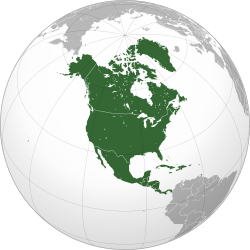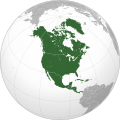Portal:North America
The North America Portal

North America is a continent in the Northern and Western hemispheres. North America is bordered to the north by the Arctic Ocean, to the east by the Atlantic Ocean, to the southeast by South America and the Caribbean Sea, and to the south and west by the Pacific Ocean. The region includes Middle America (comprising the Caribbean, Central America, and Mexico) and Northern America.
North America covers an area of about 24,709,000 square kilometers (9,540,000 square miles), representing approximately 16.5% of Earth's land area and 4.8% of its total surface area. It is the third-largest continent by size after Asia and Africa, and the fourth-largest continent by population after Asia, Africa, and Europe. As of 2021[update], North America's population was estimated as over 592 million people in 23 independent states, or about 7.5% of the world's population. In human geography, the terms "North America" and "North American" refers to Canada, Greenland, Mexico, Saint Pierre and Miquelon, and the United States.
It is unknown with certainty how and when first human populations first reached North America. People were known to live in the Americas at least 20,000 years ago, but various evidence points to possibly earlier dates. The Paleo-Indian period in North America followed the Last Glacial Period, and lasted until about 10,000 years ago when the Archaic period began. The classic stage followed the Archaic period, and lasted from approximately the 6th to 13th centuries. Beginning in 1000 AD, the Norse were the first Europeans to begin exploring and ultimately colonizing areas of North America.
In 1492, the exploratory voyages of Christopher Columbus led to a transatlantic exchange, including migrations of European settlers during the Age of Discovery and the early modern period. Present-day cultural and ethnic patterns reflect interactions between European colonists, indigenous peoples, enslaved Africans, immigrants from Europe, Asia, and descendants of these respective groups. (Full article...)
The Colorado River (Spanish: Río Colorado) is one of the principal rivers (along with the Rio Grande) in the Southwestern United States and in northern Mexico. The 1,450-mile-long (2,330 km) river, the 5th longest in the United States, drains an expansive, arid watershed that encompasses parts of seven U.S. states and two Mexican states. The name Colorado derives from the Spanish language for "colored reddish" due to its heavy silt load. Starting in the central Rocky Mountains of Colorado, it flows generally southwest across the Colorado Plateau and through the Grand Canyon before reaching Lake Mead on the Arizona–Nevada border, where it turns south toward the international border. After entering Mexico, the Colorado approaches the mostly dry Colorado River Delta at the tip of the Gulf of California between Baja California and Sonora.
Known for its dramatic canyons, whitewater rapids, and eleven U.S. National Parks, the Colorado River and its tributaries are a vital source of water for 40 million people. An extensive system of dams, reservoirs, and aqueducts divert almost its entire flow for agricultural irrigation and urban water supply. Its large flow and steep gradient are used to generate hydroelectricity, meeting peaking power demands in much of the Intermountain West. Intensive water consumption has dried up the lower 100 miles (160 km) of the river, which has rarely reached the sea since the 1960s. (Full article...)

Raymond Robert Emery (né Nichols; September 28, 1982 – July 15, 2018) was a Canadian professional ice hockey goaltender who played in the National Hockey League (NHL) for eleven seasons, between 2003 and 2015. Emery was chosen 99th overall by the Ottawa Senators in the 2001 NHL Entry Draft. During the 2006–07 season, he gained the starting job and backstopped his team to the Stanley Cup Finals, the first appearance in the finals for the modern Senators' franchise. However in the subsequent season, he lost his place as the team's starting goaltender due to an injury. He won a Stanley Cup championship with the Chicago Blackhawks in 2013.
In 2013, Emery won the William M. Jennings Trophy along with teammate Corey Crawford, awarded to the goaltender or goaltenders who give up the fewest goals in the season. Emery was a two-time Bill Masterton Memorial Trophy finalist for his dedication and perseverance. His teammates and fans often referred to him as "Razor" or "Sugar Ray" for his aggressive playing style. (Full article...)

The 1950s were pivotal for the American automobile industry. The post-World War II era brought a wide range of new technologies to the automobile consumer, and a host of problems for the independent automobile manufacturers. The industry was maturing in an era of rapid technological change; mass production and the benefits from economies of scale led to innovative designs and greater profits, but stiff competition between the automakers. By the end of the decade, the industry had reshaped itself into the Big Three, Studebaker, and AMC. The age of small independent automakers was nearly over, as most of them either consolidated or went out of business.
A number of innovations were either invented or improved sufficiently to allow for mass production during the decade: air conditioning, automatic transmission, power steering, power brakes, seat belts and arguably the most influential change in automotive history, the overhead-valve V8 engine. The horsepower race had begun, laying the foundation for the muscle car era. (Full article...)
Did you know...
- ...that the proposed Atlantica trade bloc would economically tie New England in the U.S. to the Atlantic Provinces of Canada?
- ... that Vermont coppers (pictured) were the currency used in Vermont before it became a U.S. state in 1791?
- ...that the Soufrière Hills volcano is an active complex stratovolcano with many lava domes forming its summit on the Caribbean island of Montserrat?
- ... that Raul Macias, a Cuban-Mexican boxer parlayed his popularity into a successful career in telenovelas?
- ... that during the Dead Rabbits Riot of 1857, residents of Mulberry Street in New York City were forced to barricade themselves in their homes?
Selected panorama

Topics
Categories
List articles
Related portals
Northern America
Central America
Caribbean
WikiProjects
 North America
North America-
 Canada
Canada -
 Greenland
Greenland -
 Mexico
Mexico -
 Saint Pierre and Miquelon
Saint Pierre and Miquelon -
 United States
United States  Central America
Central America-
 Belize
Belize -
 Costa Rica
Costa Rica -
 El Salvador
El Salvador -
 Guatemala
Guatemala -
 Honduras
Honduras -
 Nicaragua
Nicaragua -
 Panama
Panama  Mesoamerica
Mesoamerica Caribbean
Caribbean-
 Antigua and Barbuda
Antigua and Barbuda -
 Bahamas
Bahamas -
 Barbados
Barbados -
 Bermuda
Bermuda -
 Cuba
Cuba -
 Dominica
Dominica -
 Dominican Republic
Dominican Republic -
 Grenada
Grenada -
 Haiti
Haiti -
 Jamaica
Jamaica -
 Puerto Rico
Puerto Rico -
 Saint Kitts and Nevis
Saint Kitts and Nevis -
 Saint Lucia
Saint Lucia -
 Saint Vincent and the Grenadines
Saint Vincent and the Grenadines -
 Trinidad and Tobago
Trinidad and Tobago
Associated Wikimedia
The following Wikimedia Foundation sister projects provide more on this subject:
-
Commons
Free media repository -
Wikibooks
Free textbooks and manuals -
Wikidata
Free knowledge base -
Wikinews
Free-content news -
Wikiquote
Collection of quotations -
Wikisource
Free-content library -
Wikiversity
Free learning tools -
Wikivoyage
Free travel guide -
Wiktionary
Dictionary and thesaurus



























